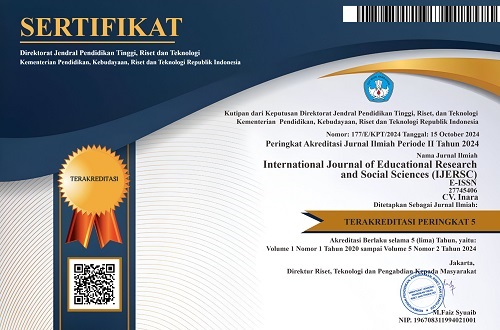The Controversy of Interfaith Marriages (A Review of The Effectiveness of Supreme Court Circular Letter Number 2 of 2023
DOI:
https://doi.org/10.51601/ijersc.v6i1.931Abstract
Marriages are often problematic, including for couples of the same religion. The problem becomes increasingly complex for those who enter into interfaith marriages. However, the reality of interfaith marriage is a social reality that cannot be avoided. The social and relational nature of humans and the need to meet other people make the potential for interfaith marriages even higher. Humans will increasingly find differences when relating to others who are diverse both in tradition, culture, thought and religion. Catholic teachings and the Code of Canon Law do not require interfaith marriages because it would bring danger to the faith of Catholics. However, the Catholic religion cannot turn away from the social reality where it is not uncommon to find husbands or wives of different religions. Therefore, the Catholic Religion must still consider pastorally interfaith marriages as regulated in Canon 1125 and 1126. In accordance with the provisions of Article 2 paragraph (1) of Law no. 1 of 1974 concerning Marriage states that a valid marriage is a marriage that takes place according to the laws of each religion. A valid marriage must be registered according to the applicable laws and regulations (Article 2 paragraph (2) of the Marriage Law). According to SEMA No. 2 of 2023 concerning Instructions for Judges in Hearing Cases of Applications for Registration of Marriages Between People of Different Religions and Beliefs in number 2 it is stated that the court does not grant requests for registration of marriages between people of different religions. So, if according to one of the religions in Indonesia an interfaith marriage is legal according to the relevant religious law, the court should not refuse to register the marriage at the Population and Civil Registry Service. This research will be carried out using sociological juridical methods using quantitative reasoning.
Downloads
References
Rusman, Y. Hidayat, and A. Rifai, “Religious Marriage in Indonesia in the Perspective of Islamic Law and Positive Law in Indonesia: Legal Comlexities and the Issuance of Supreme Court Circular Letter No. 2 of 2023,” Indones. J. Innov. Stud., vol. 24, no. 1, pp. 8–18, Nov. 2023, doi: 10.21070/ijins.v25i.975.
N. Ahmad Ridwan, P. Pujiyono, and N. Saptanti, “Controversy Over The Rejection of Interfaith Marriage Approval: Between The Circular of The Supreme Court and The Population Administration Law in Indonesia,” Int. J. Educ. Res. Soc. Sci., vol. 4, no. 6, pp. 1036–1044, Dec. 2023, doi: 10.51601/ijersc.v4i6.753.
N. Yasin, M. Musataklima, and A. Wahidi, “Interlegality Perkawinan Beda Agama Vis a Vis Surat Edaran Mahkamah Agung Nomot 2 Tahun 2023 tentang Penolakan Permohonan Pencatatan Perkawinan Beda Agama di Indonesia,” J. Penelit. Huk. Jure, vol. 23, no. 4, p. 389, Nov. 2023, doi: 10.30641/dejure.2023.V23.389-402.
C. R. Daus and I. Marzuki, “Perkawinan Beda Agama di Indonesia; Perspektif Yuridis, Agama-agama dan Hak Asasi Manusia,” Al-Adalah J. Syariah dan Huk. Islam, vol. 8, no. 1, pp. 40–64, Jun. 2023, doi: 10.31538/adlh.v8i1.3328.
E. Juandini, “Perspektif Hukum Positif dan Hukum Islam di Indonesia terhadap Perkawinan Beda Agama,” J. Educ., vol. 5, no. 4, pp. 16405–16413, Apr. 2023, doi: 10.31004/joe.v5i4.2795.
R. A. M. Yusuf and F. Lubis, “Prohibition of Interfaith Marriage: An Analysis of Judicial Guidelines for Adjudicating Marriage Registration Applications Among Different Religions and Belief,” J. Ilm. Mizani Wacana Hukum, Ekon. Dan Keagamaan, vol. 7, no. 1, p. 104, Apr. 2020, doi: 10.29300/mzn.v7i1.4891.
M. Habiburrahman, M. Maskur, and A. Shalihah, “Problematika Surat Edaran Mahkamah Agung Nomor 2 Tahun 2023 Tentang Pelarangan Pencatatan Nikah Beda Agama Dalam Perspektif Hak Asasi Manusia,” Sosio Yust. J. Huk. dan Perubahan Sos., vol. 3, no. 2, pp. 223–241, Nov. 2023, doi: 10.15642/sosyus.v3i2.550.
D. Farid, M. H. Abdulah Pakarti, H. Hendriana, and I. Fathiah, “Interfaith Marriage: Subjectivity of the Judge in Determination of No. 454/pdt.p/2018 Surakarta District Court,” Al-Istinbath J. Huk. Islam, vol. 7, no. 2, p. 355, Dec. 2022, doi: 10.29240/jhi.v7i2.4574.
N. Nurhidayati, A. F. Liberty, S. Nugraha, N. Angkasa, and F. M. Sari, “Effectiveness of Ultra Petitum Partium in Divorce Claims in Religious Courts,” Adhki J. Islam. Fam. Law, vol. 4, no. 2, pp. 91–113, Jul. 2023, doi: 10.37876/adhki.v4i2.101.
Suparto and Zulkifli, “Position of Circular Letter of The Supreme Court as A Follow-Up From The Decision of The Constitutional Court Number 37/PUU-IX/2011,” Awang Long Law Rev., vol. 5, no. 1, pp. 225–234, Nov. 2022, doi: 10.56301/awl.v5i1.554.
A. Syahputra Sirait, “Implikasi Pelaksanaan Surat Edaran Mahkamah Agung (SEMA) Nomor 3 Tahun 2014 Terhadap Eksistensi Undang – Undang Nomor 1 Tahun 1974,” FITRAH J. Kaji. Ilmu-ilmu Keislam., vol. 4, no. 1, pp. 113–128, Jun. 2018, doi: 10.24952/fitrah.v4i1.879.
G. N. Rivani and A. Gunawan, “Implementation of Religious Marriage Registration Before and After the Issuance of SEMA Number 2 of 2023 at the Yogyakarta City District Court,” Veteran Law, vol. 7, no. 2, pp. 194–2024, Aug. 2023, [Online]. Available: https://ejournal.upnvj.ac.id/Velrev/article/view/9182/3266#:~:text=Article 8 letter (f) of,be legally performed and registered.
M. U. Anshor and M. L. Sinaga, Tafsir Ulang Perkawinan Lintas Agama: Perspektif Perempuan dan Pluralisme. Jakarta: Kapal Perempuan, 2004.
Ichtiyanto, Perkawinan Campuran Dalam Negara Republik Indonesia. Jakarta: Badan Litbang Agama dan Diklat Keagamaan Departemen Agama RI, 2003.
B. J. Nasution, Metode Penelitian Ilmu Hukum. Bandung: CV. Mandar Maju, 2014.
Muhaimin, Metode Penelitian Hukum. Mataram: Mataram University Press, 2020.
Ahmad Faiz Shobir Alfikri and M. A. Rahmatullah, “Interfaith Marriage from a Legal Justice Perspective After The Supreme Court’s (SEMA) 2023 Circular Letter,” Alauddin Law Dev. J., vol. 6, no. 1, pp. 92–107, 2024, doi: 10.24252/aldev.v6i1.44215.
Z. Arifin, N. G. Bayhaqi, and D. Pradhan, “Urgency Supreme Court Circular Letter Number 2 of 2023 in The Judicial Process of Interfaith Marrige Registration,” J. Law Leg. Reform, vol. 5, no. 1, pp. 137–178, 2024,
Sri Maryati, H. Achmad, Adang Darmawan Achmad, and Mohd Anuar Ramli, “The Dynamic Landscape of Interfaith Marriage in Indonesia: Navigating The Supreme Court Circular Letter (SEMA) No. 02 of 2023 and Population Administration Law,” Daengku J. Humanit. Soc. Sci. Innov., vol. 4, no. 3, pp. 489–502, 2024, doi: 10.35877/454ri.daengku2613.
Sulistyandari et al., The Implementation of Supreme Court Circular Letter Number 2 of 2023 Regarding Marriages Between Adherents of Different Indigenous Beliefs in Indonesia, no. 2. Atlantis Press SARL, 2023. doi: 10.2991/978-2-38476-164-7_86.
H. Nathanael, “Perlindungan Hak Membentuk Ikatan Perkawinan dalam Undang-Undang Ketenagakerjaan,” J. Ilmu Huk. Aleth., vol. 4, no. 1, pp. 41–56, 2020, doi: 10.24246/alethea.vol4.no1.p41-56.
S. Cantonia, D. Ilyas, and A. Majid, “Tinjauan Yuridis Terhadap Perkawinan Beda Agama di Indonesia dalam Perspektif Undang-Undang Perkawinan dan Hak Asasi Manusia,” J. Huk. Lex Gen., vol. 2, no. 6, pp. 510–527, 2021, [Online]. Available: https://jhlg.rewangrencang.com/
F. Emanuel, D. Kwirinus, and P. Yuniarto, “the Concept of Interfaith Marriage: Islam-Catholicism and Its Implications for the Moral Educations of Children,” J. Pendidik. Sosiol. dan Hum., vol. 14, no. 1, p. 103, 2023, doi: 10.26418/j-psh.v14i1.60155.
Nikodemus and Y. Endi, “Pandangan Gereja Katolik Terhadap Perkawinan CampurPerspektif Amoris Laetitia Dan Hukum Kanonik,” Kamaya J. Ilmu Agama, vol. 6, no. 3, pp. 352–366, 2023.
K. Winga and D. N. Rupi, “Perspectives on Civil Law and the Canon Law of the Catholic Church in a Multireligious Society,” Hanifiya J. Stud. Agama-Agama, vol. 7, no. 1, pp. 41–50, 2024, [Online]. Available: https://journal.uinsgd.ac.id/index.php/hanifiya/article/download/33604/10673
T. Raharso, Paham Perkawinan Dalam Hukum Gereja Katolik. Malang: Penerbit Dioma (Anggota IKAPI dan Anggota Seksama), 2014.
H. I. Pandego, “MIX MARRIAGE (CANON 1124) The Ecumenical Spirit and Pastoral Approaches,” J. Filsafat-Teologi, vol. 16, no. 2, 2019, doi: https://doi.org/10.54367/logos.v16i2.1030.
Downloads
Published
How to Cite
Issue
Section
License
Copyright (c) 2025 International Journal of Educational Research & Social Sciences

This work is licensed under a Creative Commons Attribution 4.0 International License.






















